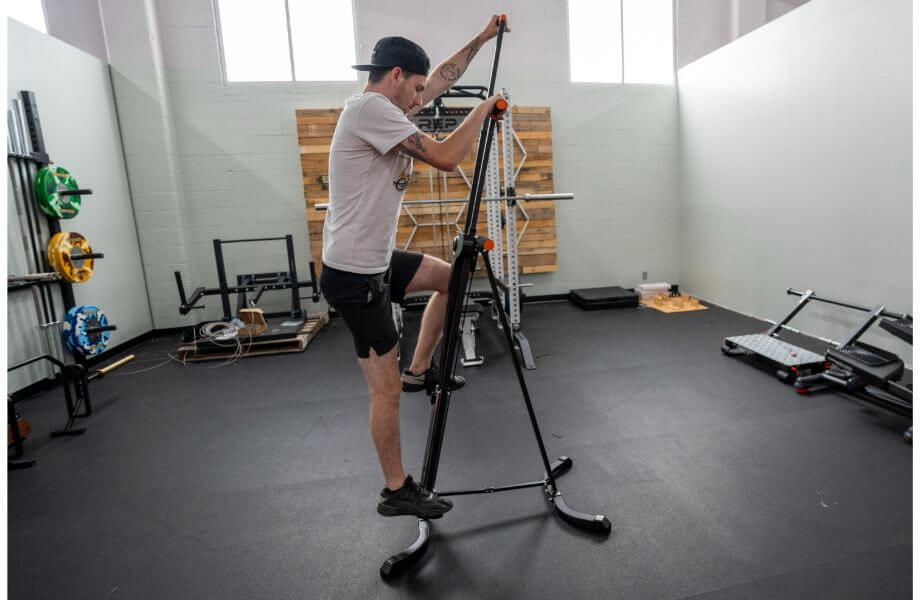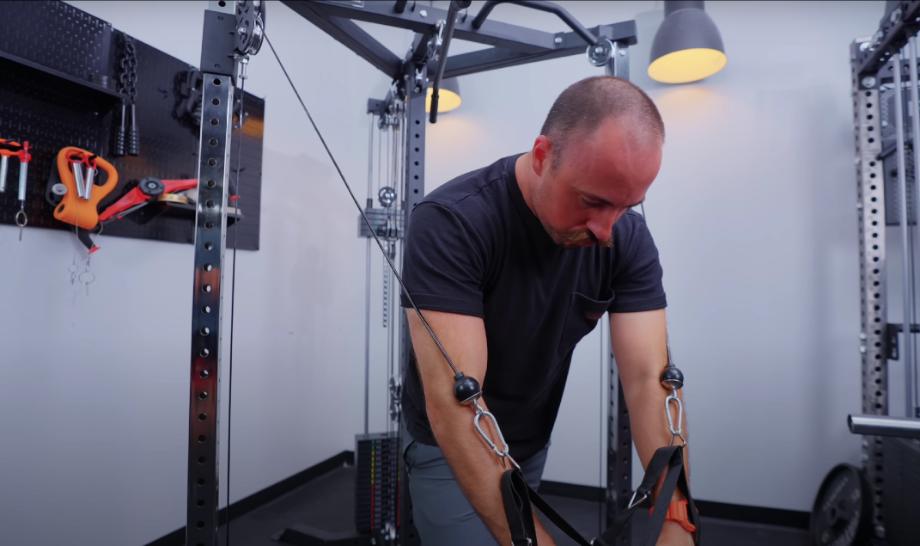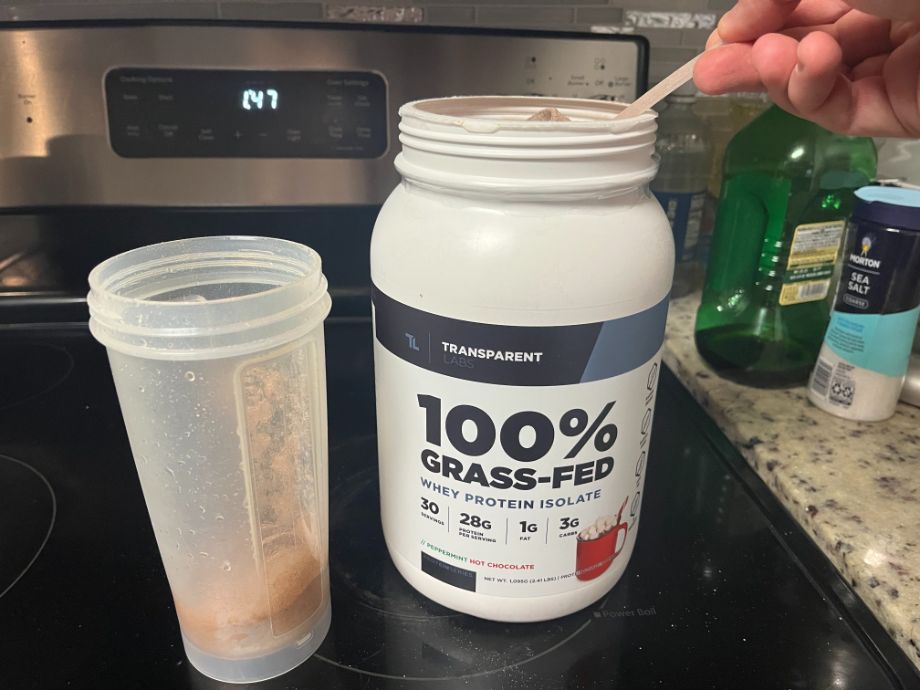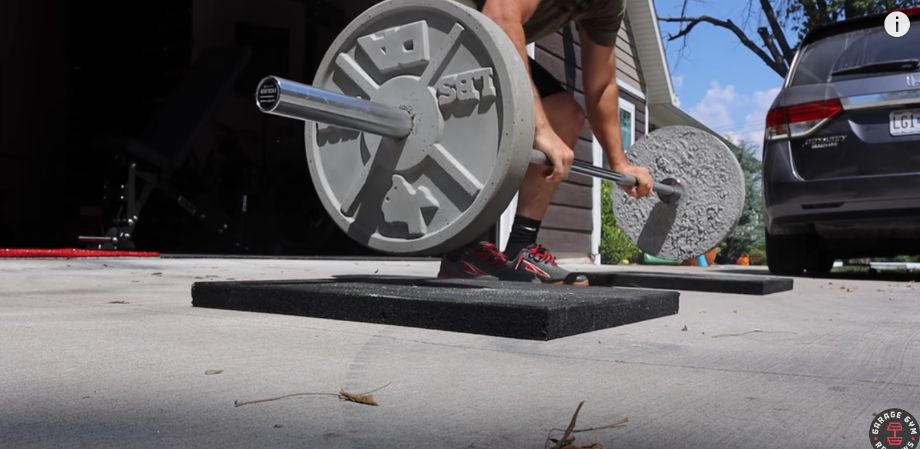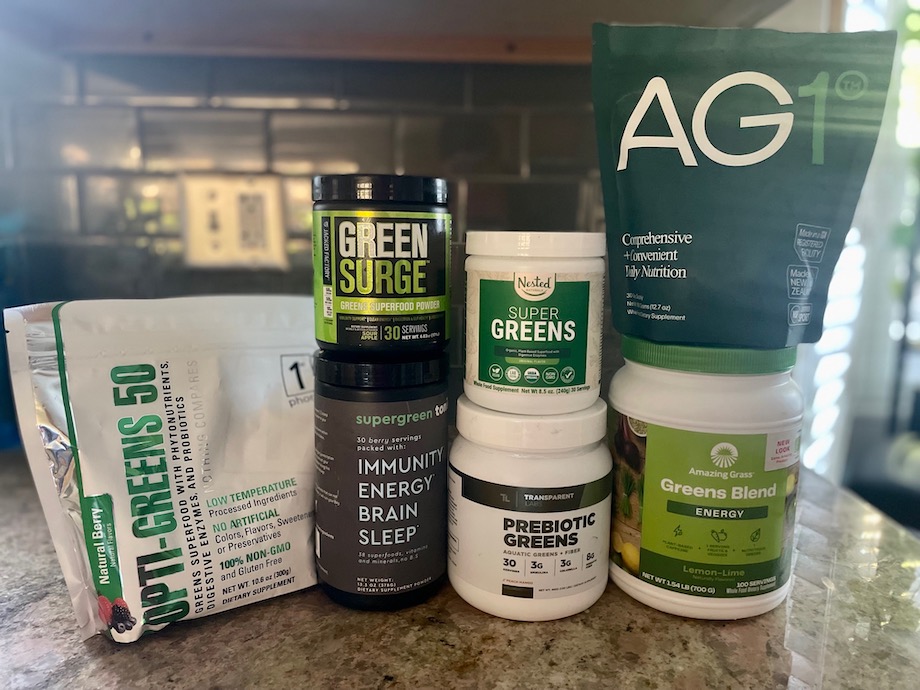Vertical climbers have become quite popular in recent years. With celebrity athletes such as LeBron James attesting to their efficiency, such a surge in interest by fitness enthusiasts comes as no surprise.
Beyond the hype, I define the best fitness machines as the ones that offer the most benefits with the least impact on my joints and time. Therefore, I consider vertical climbers as one of the best high-quality workout machines out there today, and I want to share my picks for the best vertical climber workouts a variety of trainees could engage in.
Vertical climbers offer weight loss, strength, and cardio benefits while delivering a low-impact exercise, making them a great go-to strength and cardio machine for just about everybody looking to achieve their fitness goals and improve their overall wellness. Whether you’re dealing with the Maxiclimber, Versaclimber, CLMBR, or the best budget vertical climbing machine you found on Amazon, what is certain is a dynamic and efficient workout if appropriately used.
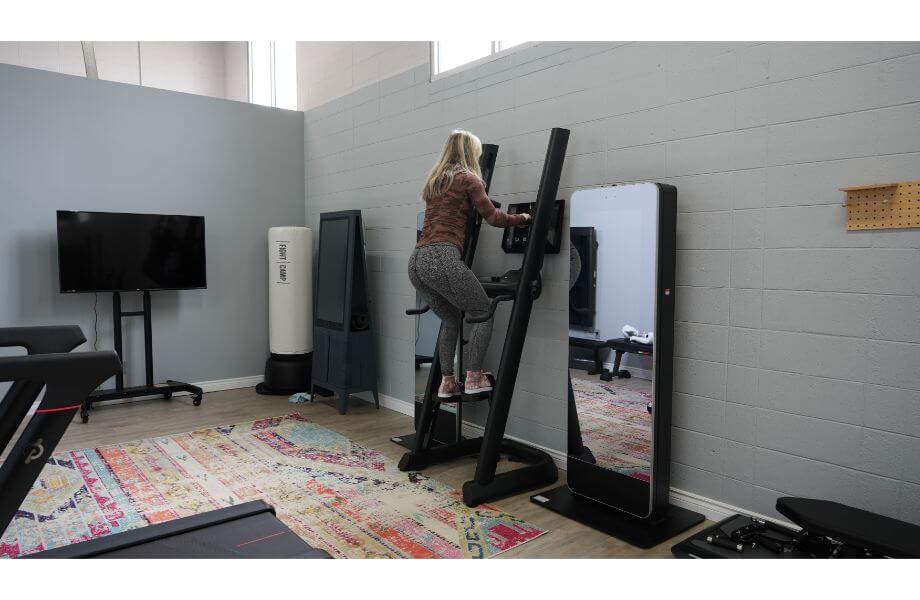
In this article, I’ll explain further some of this machine’s excellent benefits and help introduce both beginner and advanced athletes to some of the best vertical climber workouts you can do to get the most out of this simple, yet highly beneficial, device.
Benefits of Using a Vertical Climber
Vertical climbers offer a total-body workout that is low-impact, high-intensity, and great for weight loss and toning due to the simultaneous strength and cardio workout experienced when using them. Similar to a stair-stepper, I would describe vertical climbers as a fusion of rock climbing and stair-stepping that provides quite a bit of bang for your buck.
In saying this, here are a few of their most notable benefits:
Full-Body Cardio Workout in Less Time
Vertical climbers can burn a ton of calories and offer a great full-body cardio workout. A 1995 study found1 that vertical climbing stimulates significantly greater VO2max than treadmills or rowing machines. VO2max is a scientific term for how your body uses oxygen and how that conveys energy used and calories burned.
Simply put, vertical climbers can increase your heart rate and burn calories quicker than other exercise machines, making them great for those of us short on time and looking to lose bodyweight and build endurance.
Low-Impact Exercise
Vertical climbers offer a low-impact, high-intensity exercise that is accessible to many people. Similar to an elliptical or an exercise bike, but unlike running, when vertical climbing, your joints won’t experience repeated impact of a stride and you won’t be exerting problematic weight on your knees or feet, which could lead to inflammation or worsening existing joint pain.
This makes vertical climbers great for people with chronic pain, athletes overcoming injuries, or just an efficient go-to exercise that can help preserve one’s joints for the long term. Vertical climbers like the CLMBR offer a 350-pound weight capacity, too, so users of many sizes can feel secure using the machine.
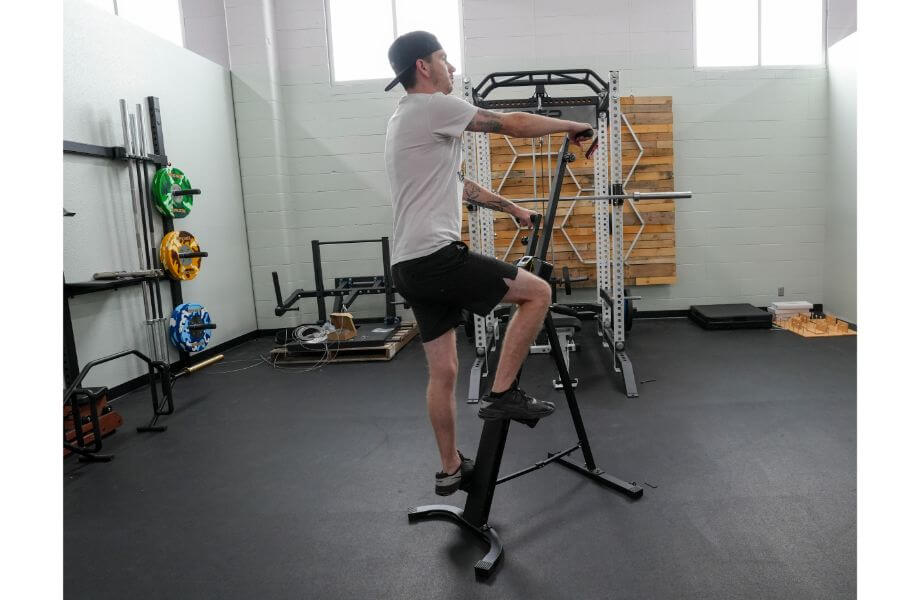
Helps Build Muscle
Exercising on a vertical climber helps to work the upper body, core, and lower body. This is because your shoulders, arms, abdomen, glutes, and quads are all activated in the climbing motion. Furthermore, with most machines offering adjustable resistance levels, you can easily increase the intensity of your climb’s strength and muscle-building benefits.
While you may not see the same type of major muscle group gains experienced with heavy free weights, for those seeking a shredded look, vertical climbers could be an excellent choice to help lean out.
Small Footprint
Vertical climbers are a great addition to any home gym, as they have a much smaller footprint than similar exercise equipment, making them perfect for small spaces. This is due to their upright build, the steel frame’s adjustable height, and most models being foldable for easy storage. You will need the ceiling height clearance to use these machines though—about eight feet for most models.
Vertical Climber Workout for Beginners
If you don’t have a CLMBR to access on-demand classes led by personal trainers via the touchscreen, we’ve got you covered. Here is a great 10-minute vertical climb session for those just dipping their toes into the vertical climber space.
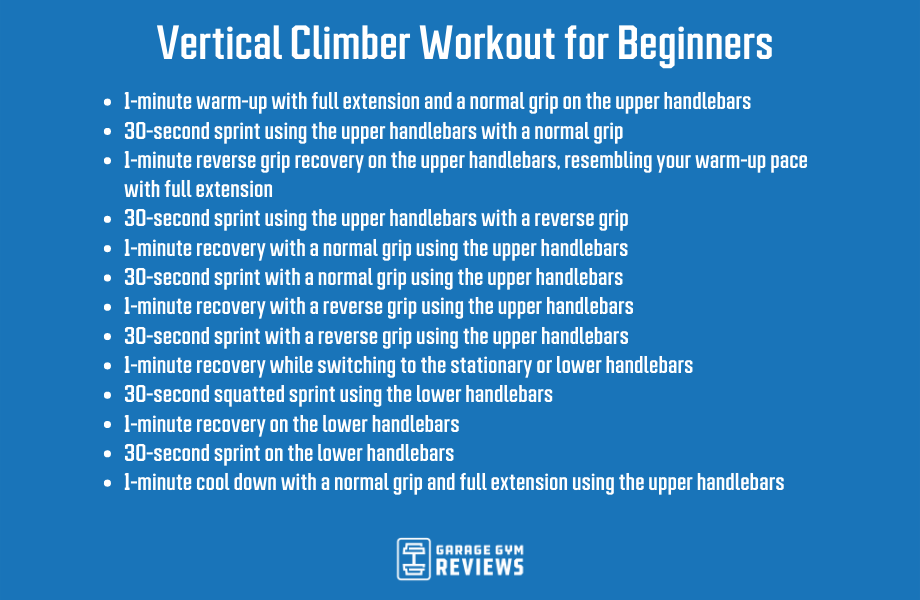
- 1-minute warm-up with full extension and a normal grip on the upper handlebars
- 30-second sprint using the upper handlebars with a normal grip
- 1-minute reverse grip recovery on the upper handlebars, resembling your warm-up pace with full extension
- 30-second sprint using the upper handlebars with a reverse grip
- 1-minute recovery with a normal grip using the upper handlebars
- 30-second sprint with a normal grip using the upper handlebars
- 1-minute recovery with a reverse grip using the upper handlebars
- 30-second sprint with a reverse grip using the upper handlebars
- 1-minute recovery while switching to the stationary or lower handlebars
- 30-second squatted sprint using the lower handlebars
- 1-minute recovery on the lower handlebars
- 30-second sprint on the lower handlebars
- 1-minute cool down with a normal grip and full extension using the upper handlebars
Tips:
- Make sure you are keeping a composed posture and activated core when climbing. In addition, lean toward the machine rather than away from it when climbing.
- Make sure you fully extend the upper handlebars while in recovery mode and move as quickly as possible during sprints.
- You will notice a more intense effect on your biceps when holding the handlebars with a reverse grip.
- Use the recovery rounds to catch your breath. However, you should still feel a full-body workout during these rounds. They are not intended to be a full break.
20-Minute Vertical Climber Cardio Workout
Get your heart pumping with this 20-minute vertical climber cardio workout.
Repeat the workout twice, finishing off with a 2-minute normal grip, lower-handlebar, slow- to moderate-paced cool-down jogging stride:
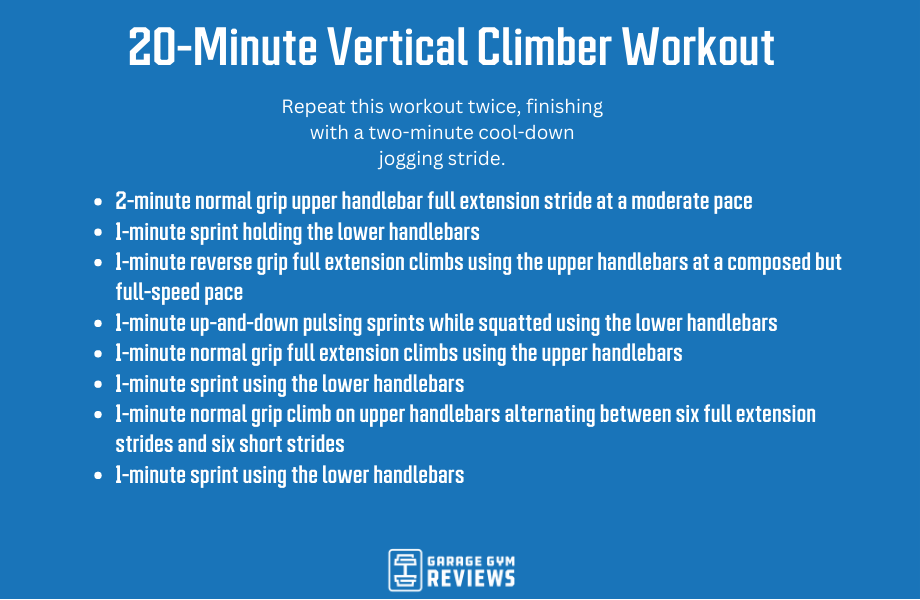
- 2-minute normal grip upper handlebar full extension stride at a moderate pace
- 1-minute sprint holding the lower handlebars
- 1-minute reverse grip full extension climbs using the upper handlebars at a composed but full-speed pace
- 1-minute up-and-down pulsing sprints while squatted using the lower handlebars
- 1-minute normal grip full extension climbs using the upper handlebars
- 1-minute sprint using the lower handlebars
- 1-minute normal grip climb on upper handlebars alternating between six full extension strides and six short strides
- 1-minute sprint using the lower handlebars
Tips:
- This workout is a structured guideline. The intensity of your pace should reflect your current fitness status. It’s best to remain consistent and focus on getting through the whole workout rather than a single interval. Do this by always focusing on your breathing and maintaining a pace that challenges you but won’t lead you to need to stop suddenly.
- Like any workout routine, it’s essential to try and push yourself, but make sure you do so in a way that doesn’t compromise your technique, composure, or ability to complete the entire workout.
HIIT Vertical Climber Workout
Step up on those foot pedals and jump into this 25-minute high-intensity interval vertical climbing workout.
Repeat the workout twice, finishing off with a one-minute normal-grip, upper-handlebar, slow- to moderate-paced cool-down stride:
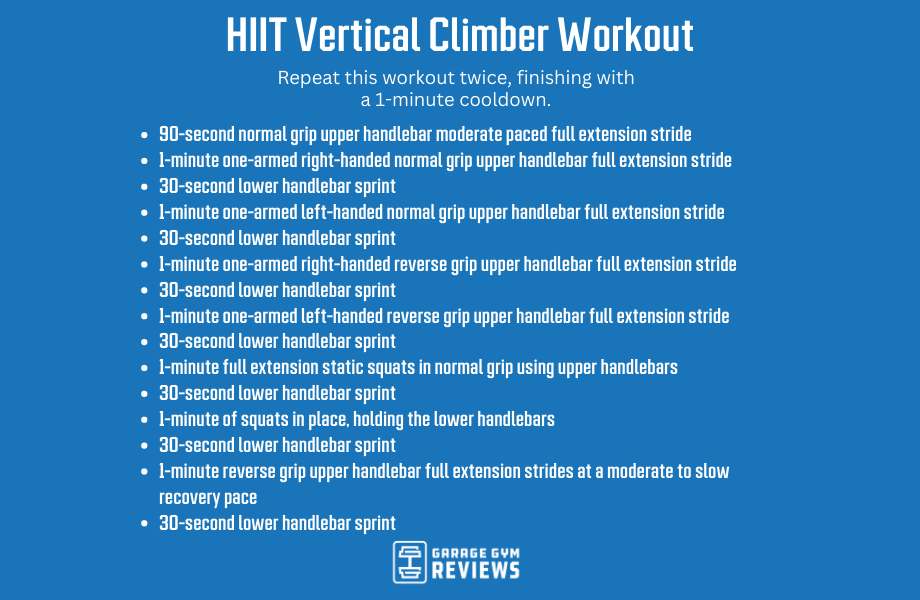
- 90-second normal grip upper handlebar moderate paced full extension stride
- 1-minute one-armed right-handed normal grip upper handlebar full extension stride
- 30-second lower handlebar sprint
- 1-minute one-armed left-handed normal grip upper handlebar full extension stride
- 30-second lower handlebar sprint
- 1-minute one-armed right-handed reverse grip upper handlebar full extensions stride
- 30-second lower handlebar sprint
- 1-minute one-armed left-handed reverse grip upper handlebar full extension stride
- 30-second lower handlebar sprint
- 1-minute full extension static squats in normal grip using upper handlebars
- 30-second lower handlebar sprint
- 1-minute of squats in place, holding the lower handlebars
- 30-second lower handlebar sprint
- 1-minute reverse grip upper handlebar full extension strides at a moderate to slow recovery pace
- 30-second lower handlebar sprint
Tips:
- Keep your opposite arm behind your back for balance when engaging in the one-armed full-extension upper handlebar strides.
- Make sure you are not bouncing or moving your head or back during your static squats, only engaging in a full-extension stride from a lowered squat position using only your arms, core, and legs.
- Use the slower, strength-focused exercises to catch your breath from the intensity of your sprints, and the sprints to feel some relief from the stress of the strength-focused exercises.
- When cooling down, focus on really getting a stretch in your full extension strides.
Best Vertical Climber Workouts: Q&A
What muscles does a vertical climber work?
Vertical climbers offer a total-body workout experience. Your hamstrings, quads, glutes, arms, back, core, shoulders, and chest can all be engaged by using a vertical climber. For example, the most basic climbing exercise, a full-extension upper handlebar stride, works your whole body. Furthermore, you can stimulate your engaged muscles more intensely by increasing the magnetic resistance most vertical climbing machines offer.
Do vertical climbers build muscle?
Vertical climbing machines are best used for toning rather than gaining muscle mass. This is because when vertical climbing, you experience a simultaneous cardio and strength training experience, leading to you burning fat and increasing muscular endurance simultaneously.
If you want to get big, there may be better fitness equipment to incorporate into your home workout than a vertical climber machine. However, if you’re looking for a more shredded look and to build lean muscle, this is a definite go-to.
Do vertical climbers build glutes?
Absolutely! Your glutes are more or less constantly engaged when training on a vertical climber, regardless of exercise. Of course, the stationary or lower handlebar exercises better target the glutes specifically. But overall, a vertical climber should definitely be on your radar if you’re looking to tone or build your glutes.
References
Brahler C J, Blank S E. VersaClimbing elicits higher VO2max than does treadmill running or rowing ergometry. Med Sci Sports Exerc. 1995 Feb;27(2):249-54. PMID: 7723649 (1995)


